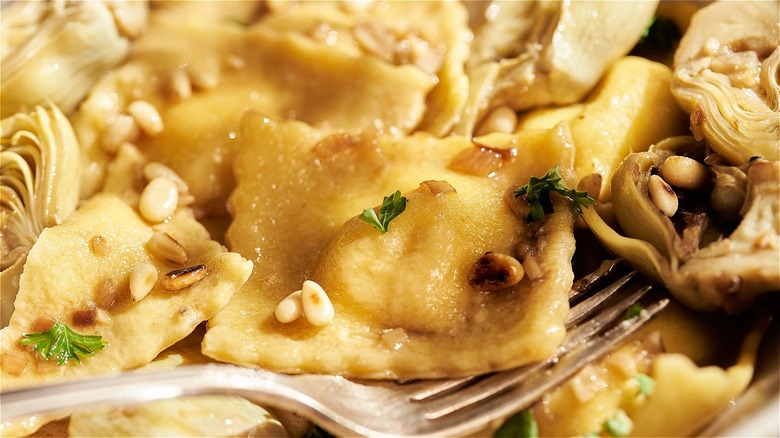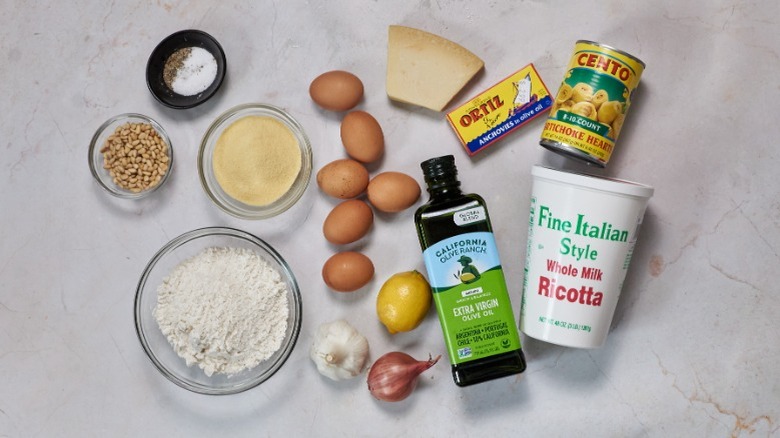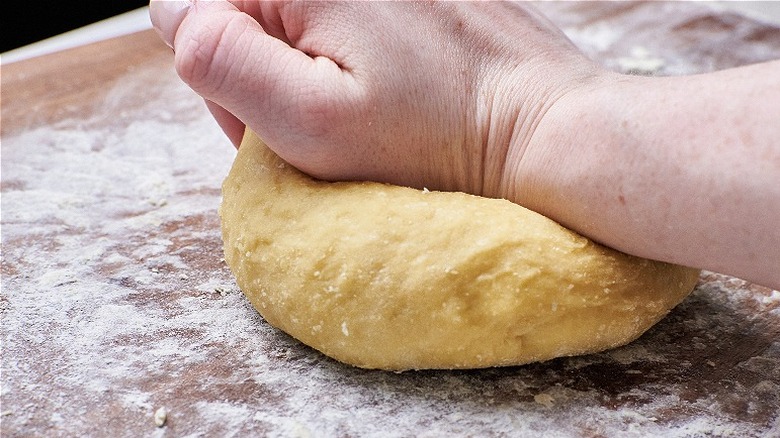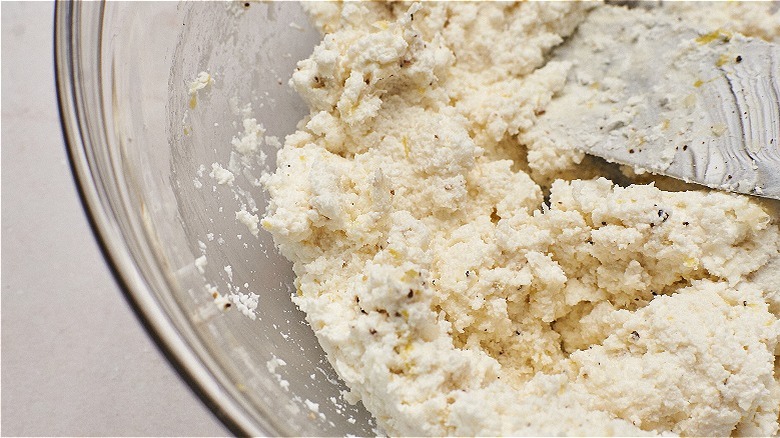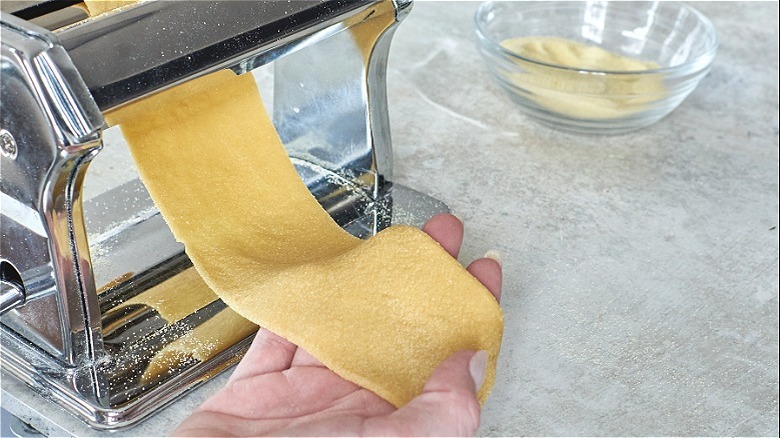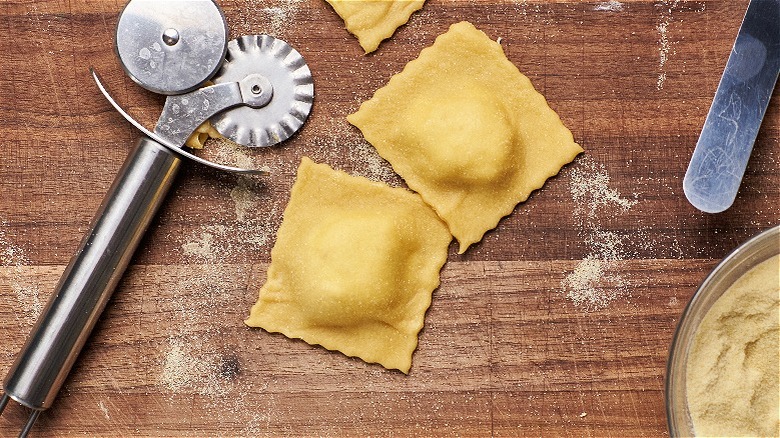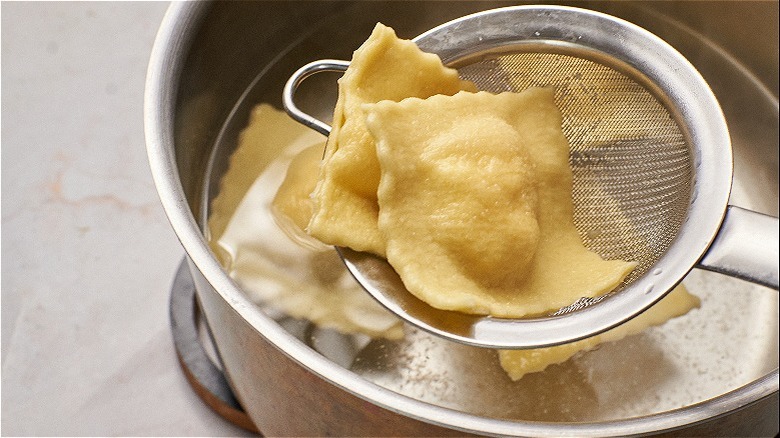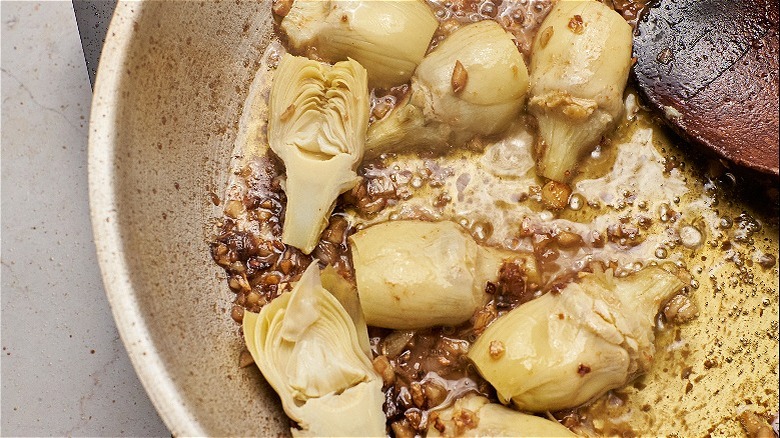Cheese Ravioli With Lemon-Artichoke Sauce Recipe
Soft, pillowy pockets of cheesy pasta are not as hard to make from scratch as you think. Ravioli are formed from two thin sheets of pasta, cut into squares with a pastry wheel around little balls of filling. It takes a couple of hours from start to finish, but making pasta isn't really meant for busy weeknights. Save this one for date night, Sunday afternoon, or a quiet evening alone when you can dedicate a few hours to kneading, rolling, and sheeting balls of flour. Oh, and don't forget the charcuterie to tide you over in the meantime.
This recipe developed by Michelle McGlinn is a rich egg yolk pasta stuffed with lemony ricotta and dressed up with artichokes and oil. It's simple and rustic, but bursting with the bright flavor of lemon and mellow toasted pine nuts. If you don't have time to make the ravioli, just pick up a pack from the store and give the sauce a try; it comes together in less than 10 minutes and is perfect with any cheese-filled pasta.
Everything you need for cheese ravioli with lemon-artichoke sauce
For the ravioli, you'll just need eggs and flour. We love using tipo 00 flour, which is a very finely ground flour that makes soft and smooth pasta. If you can't find it, try seeking out semolina before turning to regular all-purpose. Any flour will work, but the cooked texture will vary. Semolina will be a little rougher, which will help sauces stick even better. We use semolina here to dust our surfaces and give the pasta some grip, but you can also use whatever flour you have on hand.
For the filling, you'll need ricotta, lemon zest, parmesan, garlic, salt, and pepper. Buy a whole milk, thick ricotta to avoid needing to drain and get fresh parmesan for better flavor.
For the sauce, you'll need olive oil, lemon juice, garlic, shallot, anchovies, canned artichokes, and pine nuts. Don't let the anchovies scare you — they dissolve in the hot oil for an umami flavor, but you'll need good-quality anchovies for this. Seek out the thin pinkish filets found in tins or jars in Italian markets (and try to avoid the cheap stuff).
Form the flour into a dough
This is probably the trickiest part of pasta making, but also the most forgiving (and messy). Some expert makers will crack the eggs directly into the flour, but to make things a little easier, we recommend beating the eggs in a bowl before slowly adding the eggs into the mound. The first part of this step will seem a little funny, especially if your eggs escape from the flour. Don't sweat it: Just use a large surface and combine the flour and egg as much as possible. When it's a little doughy, stringy, and sticking to your fork, start using your hands to form the mixture into a ball of dough.
Once you have a sturdy ball of dough formed (it's like magic, right?) flour the surface a bit and begin kneading. Drive the heel of your palm into the dough and fold it over, repeating the motion until the dough is springy. To test, roll it into a ball and poke the top. If it springs back, it's ready.
Make the filling
The dough will need to rest for around 30 minutes to allow the gluten to relax so you can properly stretch and roll, so in the meantime, pull together the filling. It's important your ricotta is thick for this recipe — if it's watery, the filling will ooze out of the ravioli while it cooks. If you can't find good, thick ricotta, you can drain your ricotta in a fine strainer or cheesecloth overnight to remove moisture, much like making labneh.
Once you have drained ricotta, stir it together with grated garlic, lemon zest, parmesan, and salt and pepper. We know it's a big bowl of cheese, but give it a taste. It should be savory and very flavorful. If it tastes bland, add more salt and pepper.
Sheeting pasta
If you've made pasta before, this step will be familiar to you. Break the rested dough into sections and wrap up the sections that aren't in use. You don't want to let pasta dough dry out while you're using it, so anytime you aren't rolling or sheeting, make sure the dough is covered.
Flour a surface and your pasta maker, then lightly roll the section of dough into a thin sheet. You don't need a lot of elbow grease here, just enough that the dough can fit into the first setting on the pasta sheeter. Feed the dough into the widest setting, then fold it over and roll it through the same setting again. This strengthens the sheet for the remaining settings and can be used anytime your dough gets snagged or rips.
Feed the dough through the remaining settings until the dough is thin enough to see your hand through — you'll faintly see the color of your skin, but the dough won't be completely translucent. Set the dough on a floured surface and cover to avoid drying out.
Forming ravioli
This part is kind of fun, especially if you found sheeting to be a little frustrating. Set a sheet of dough on a lightly floured surface and plop a hefty teaspoon of ricotta filling onto the middle. Continue dropping spoonfuls of ricotta about an inch apart down the middle of the sheet until you run out of room, then lightly wet the pasta with water (you can just use your finger for this). Set a sheet on top and press down to seal, working gently with your fingers to remove any air bubbles. At this point, nothing needs to be perfect (not that it ever needs to be) because you'll be trimming these down into squares.
If you have a ravioli stamp, feel free to use it here, but otherwise you can use a fluted pastry wheel or a simple paring knife to trim the ravioli. Don't overthink it: Roll the wheel about a half inch away from the ricotta ball in every direction until you get a neat little square.
Cook the ravioli
Fresh pasta cooks very quickly, especially when it hasn't been dried. Drop the raviolis into salted boiling water and boil for about a minute or so, or until they float to the top. If the dough looks a little tough, it may be undercooked and need a minute longer in the water. Scoop the cooked ravioli out with a slotted spoon and set aside for saucing.
Bring the sauce together
This sauce is super simple and can be used for any pasta, not just ravioli (it's also very good with spaghetti). Before starting, toast the pine nuts for about a minute on the dry skillet, then remove. The secret to all the flavor is in the anchovies, which melt into the oil for a hidden umami-punch. Heat the oil and drop in the anchovies, shallot, and garlic. Squeeze in the lemon juice and add the artichoke hearts, then sauté until the artichokes are golden. Add a little bit of reserved pasta water and simmer to reduce a bit before adding the cooked ravioli. Toss everything together, then serve with the toasted pine nuts.
This pasta is delicious with a semi-dry white wine and alongside baked fish. You can also serve the ravioli with roasted vegetables like carrots, broccoli, or kale. It keeps in an airtight container for up to a week in the fridge, or you can freeze the uncooked ravioli to cook later. With all that work, it's worth saving some for your future self.
Cheese Ravioli With Lemon-Artichoke Sauce Recipe
Make your own homemade cheese ravioli filled with ricotta and parmesan. Serve them in a bright sauce featuring lemon juice, artichokes, and pine nuts.
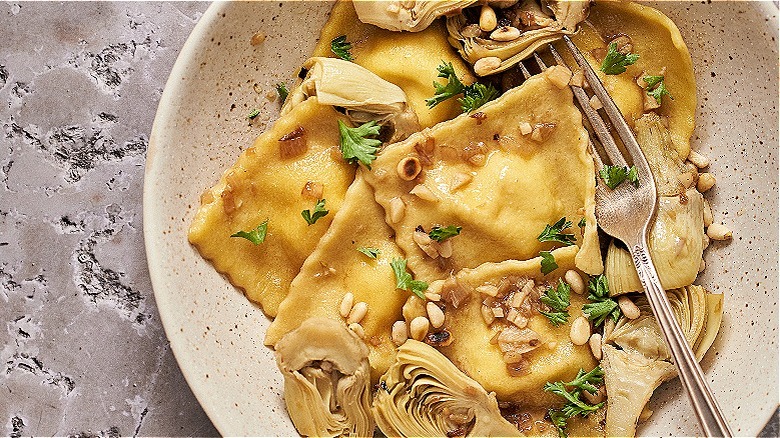
Ingredients
- 4 egg yolks
- 2 whole eggs
- 2 ¼ cups Tipo 00 flour
- ½ cup semolina flour
- ¾ cup whole milk ricotta, drained
- ½ cup freshly grated parmesan
- Zest from ½ lemon
- 4 cloves garlic, divided
- Salt and pepper, to taste
- 2 tablespoons pine nuts
- 3 tablespoons extra-virgin olive oil
- 1 small shallot, finely diced
- 5 anchovy filets
- 10 artichoke hearts, halved
- Juice from ½ lemon
Optional Ingredients
- Parsley, for serving
Directions
- Whisk the yolks and eggs together to combine. Pour 00 flour on a large surface and form into a mound, then make a hole in the center. Pour the beaten eggs into the hole a little bit at a time, carefully combining the egg with flour until the flour is coated.
- Once flour is coated in egg, use your hands to knead the flour into a dough. As a dough forms, knead using the heel of your palm, pushing the dough outward, then fold it over and repeat the motion again. Knead until dough springs back when poked with your forefinger.
- Wrap dough in plastic and let it rest for 30 minutes.
- In the meantime, stir together the ricotta, parmesan, and lemon zest, then grate 1 clove of garlic into the mixture and combine. Taste and season with salt and pepper as desired.
- Once dough has rested, cut into quarters and cover ¾ of the dough with a towel. Lightly flour your work surface and pasta machine with semolina, then roll the dough out with a rolling pin until flat. Work the dough through the machine from the largest setting to the second thinnest setting, or until you can see your hand through the dough. Set aside and cover with a towel, then repeat with the remaining 3 pieces of dough.
- To form the ravioli, spoon 1 teaspoon of the ricotta mixture onto one pasta sheet, repeating across the sheet until you run out of space. Dip your finger in water and run it along the edges and between each ricotta ball to moisten, then place a second pasta sheet on top. Work any air bubbles out, then press down on the pasta to join them together. Using a pastry wheel, trim the pasta sheets into square raviolis by slicing between each ball of ricotta and around the edges.
- To cook the ravioli, drop into salted boiling water and cook for about 1 to 2 minutes, or until raviolis float to the surface. Once cooked, reserve ½ cup of pasta water.
- To make the sauce, first toast the pine nuts in a dry skillet until lightly browned, then remove. Add oil to the skillet along with 3 cloves minced garlic, shallot, and anchovies, and sauté until the aromatics are softened and the anchovies have dissolved. The shallot and onions will be dark brown.
- Squeeze in the lemon juice, then add the artichoke hearts and sauté cut-side down to brown.
- When ready to serve, add the reserved pasta water and simmer to reduce slightly. Season with salt and pepper if needed – you may not need any additional seasoning. Toss in the ravioli to coat. To serve, sprinkle with toasted pine nuts and top with parsley and extra grated parmesan, if desired.
Nutrition
| Calories per Serving | 859 |
| Total Fat | 31.5 g |
| Saturated Fat | 10.9 g |
| Trans Fat | 0.0 g |
| Cholesterol | 266.7 mg |
| Total Carbohydrates | 111.0 g |
| Dietary Fiber | 21.5 g |
| Total Sugars | 5.1 g |
| Sodium | 1,306.4 mg |
| Protein | 40.0 g |
